
TNU Journal of Science and Technology
229(06): 348 - 356
http://jst.tnu.edu.vn 348 Email: jst@tnu.edu.vn
CHEMICAL FRACTION ANALYSIS OF LEAD (Pb) IN SEDIMENT
AT THE GOLD MINING AREA OF THAN SA COMMUNE, VO NHAI DISTRICT,
THAI NGUYEN PROVINCE
Phan Thanh Phuong, Vuong Truong Xuan*
TNU - University of Sciences
ARTICLE INFO
ABSTRACT
Received:
08/5/2024
Mining operations have significantly impacted the environment, soil,
water, and sediment within the vicinity of gold mining activities. The
objective of this study is to analyze the chemical speciation of Pb in
sediment samples from the Than Sa gold mining area to obtain
comprehensive information regarding the level of Pb contamination in
sediment samples from this area. Employing a sequential extraction
procedure, the various forms of lead were extracted from six sediment
samples. Using the ICP-MS method, the concentrations of lead and its
chemical forms in the sediment samples were quantified. Results
indicate that the mean total lead concentration in the sediment samples
ranged from 29.16 ÷ 89.19 mg/kg, all of which were below the
allowable threshold for lead according to Vietnamese regulations for
freshwater sediments. The distribution of lead chemical forms in the
soil samples predominantly follows the sequence F5 > F3 > F2 ~ F4 ~
F1. Assessment based on environmental risk evaluation parameters
such as Igeo and RAC reveals that lead concentrations in the sediment
samples pose low to moderate levels of risk of pollution.
Revised:
31/5/2024
Published:
31/5/2024
KEYWORDS
Chemical fractionation
Lead content
Heavy metal
Gold mine
Sediment
PHÂN TÍCH DẠNG HOÁ HỌC CỦA CHÌ (Pb) TRONG MẪU TRẦM TÍCH KHU
VỰC KHAI THÁC VÀNG XÃ THẦN SA, HUYỆN VÕ NHAI, TỈNH THÁI NGUYÊN
Phan Thanh Phương, Vương Trường Xuân*
Trường Đại học Khoa học – ĐH Thái Nguyên
THÔNG TIN BÀI BÁO
TÓM TẮT
Ngày nhận bài:
08/5/2024
Môi trường, đất, nước và trầm tích ở khu vực mỏ khai thác vàng bị ảnh
hưởng nghiêm trọng bởi các hoạt động khai thác. Mục đích của nghiên
cứu này là phân tích dạng hóa học của Pb trong các mẫu trầm tích ở khu
vực mỏ vàng Thần Sa để có đầy đủ thông tin về mức độ ô nhiễm Pb
trong các mẫu trầm tích ở khu vực này. Quy trình chiết tuần tự được áp
dụng để chiết các dạng liên kết của chì trong 6 mẫu trầm tích. Hàm
lượng của chì trong các mẫu trầm tích và các dạng hóa học được định
lượng bằng phương pháp ICP-MS. Kết quả cho thấy, hàm lượng chì
tổng số trung bình trong các mẫu trầm tích nằm trong khoảng 29,16 ÷
89,19 mg/kg, và đều thấp hơn giới hạn cho phép của chì theo quy chuẩn
Việt Nam đối với trầm tích nước ngọt. Dạng hóa học của bạc trong các
mẫu đất phân bố chủ yếu ở dạng F5 > F3 > F2 ~ F4 ~ F1. Dựa trên các
thông số đánh giá nguy cơ rủi ro môi trường Igeo và RAC cho thấy,
hàm lượng chì ở các mẫu trầm tích nằm ở mức độ rủi ro ô nhiễm ở mức
thấp hoặc rủi ro vừa phải.
Ngày hoàn thiện:
31/5/2024
Ngày đăng:
31/5/2024
TỪ KHÓA
Phân đoạn hóa học
Hàm lượng bạc
Kim loại nặng
Mỏ vàng
Trầm tích
DOI: https://doi.org/10.34238/tnu-jst.10318
* Corresponding author. Email: xuanvt@tnus.edu.vn

TNU Journal of Science and Technology
229(06): 348 - 356
http://jst.tnu.edu.vn 349 Email: jst@tnu.edu.vn
1. Introduction
Extracting heavy metals and gold yields considerable economic advantages for the region;
however, it invariably results in environmental contamination within the vicinity of the mining
site. One of the significant environmental issues rendered by gold mining activities is the
contamination of water resources with hazardous substances such as mercury and cyanide, which
are commonly used in the gold extraction process. Mercury is particularly concerning due to its
bioaccumulative nature, posing risks to human health and wildlife when it enters the food chain
[1], [2]. Additionally, the disposal of mining waste, known as tailings, presents a significant
environmental challenge. Tailings contain residual metals and chemicals that can leach into the
soil and water, contaminating the environment and posing long-term risks to human and
ecological health [1]. Therefore, it is necessary to study the total content and chemical fraction of
heavy metals such as Pb to evaluate the environmental situation of this area rendered by the
mining activities.
Previous studies have often relied on the total content of metals to assess their pollution levels.
However, for a more comprehensive evaluation, it is necessary to analyze the chemical forms of
these metals in the soil [3], [4]. The Tessier sequential extraction procedure is a commonly used
method in many studies to analyze the chemical forms of heavy metals in soil and sediment [5]–
[8]. This procedure enables the extraction of five main forms of metals in soil, namely
exchangeable form (F1), carbonate form (F2), Fe/Mn hydroxide-oxide bound form (F3), organic
matter bound form (F4), and residual form (F5) [9]. Metals in the F1 form are bound to colloidal
particles in sediment (clay, iron oxide hydrates, manganese oxide, humic acid) by weak adsorption
forces. Metals in this form in sediment are highly mobile and can easily be released back into the
water environment with changes in the ion strength of water [9]. Metals existing in the form of
carbonate precipitates (F2) are highly sensitive to changes in the pH of the solution. When the pH
of the soil solution decreases, metals in this form will be released in a freely exchangeable form).
Metals in the F3 form are adsorbed on the surface of Fe-Mn oxide hydroxides and are unstable
under reducing conditions. Therefore, the oxidation state of iron and manganese will change under
these conditions, causing metals in the soil to be released into the water phase [9]. In the F4 form,
metals bound to organic matter are not stable under oxidizing conditions. In this case, these
compounds will decompose, and metals will be released into the water phase. In the residual form
(F5), naturally occurring mineral salts can trap metal traces in their stable structure. Therefore,
metal ions in this form will not dissolve under natural conditions [9].
The gold mining area of Than Sa commune, Vo Nhai district, Thai Nguyen province,
Vietnam, is known not only for being a gold mining area in Thai Nguyen but also for the serious
environmental pollution in this region. Both authorized and unlicensed gold mining that uses
cyanide and mercury can have detrimental effects on people and the environment if left
untreated. This region is the site of illicit gold mining. A common method employed in this illicit
mining is small-scale manual gold mining that uses mercury amalgam. There are detrimental
effects of illegal gold mining on the local ecosystem. Water sources are contaminated when
rivers and streams are dug up for gold mining. Certain lush areas have been mostly neglected and
are unusable for farming or production. Because of this, there is a significant chance that human
mining activities contaminate the water, soil, and sediment in this area with heavy metals such as
lead. To date, there has been no research investigating the chemical forms of Pb in sediment in
this area. To obtain more comprehensive information on the chemical forms and contamination
risk level of Pb in the soil in this area, we conducted this study to (1) analyze the total content
and chemical forms of Pb in sediment samples; (2) assess the contamination risk level of Pb in
the soil in this area based on environmental assessment indices, including the individual
contamination factor (ICF) and the Risk Assessment Code (RAC).

TNU Journal of Science and Technology
229(06): 348 - 356
http://jst.tnu.edu.vn 350 Email: jst@tnu.edu.vn
2. Methods
2.1. Sediment samples
The sediment samples analyzed were selected from six different zones within the Than Sa
gold mine area. Sediment samples were collected at a depth of 20 cm. The locations of sediment
sampling for the study are described in Table 1.
Table 1. The sediment sampling locations in the Than Sa commune gold mine
No.
Sediment Code
Coordinate y
Coordinate x
Description
1
L1
21.8897292
105.9419493
Sediment samples collected from a small stream
with clear water
2
L2
21.8871029
105.9413435
Sediment samples were collected from the
stream flowing from the Khau Au gold mine
located in Kim Ngan, Bac Kan province.
3
L3
21.8866356
105.9416627
Sediment samples collected from the area of a
gold mining cave that has been filled, containing
gold tailings
4
L4
21.8888930
105.9293818
Sediment samples were collected from the
stream area near the entrance of the Thu Do Gio
Ngan Trading Company Limited, with two main
streams: Khau Au and Kim Ngan, located in
Than Sa, where mineral extraction activities are
currently taking place
5
L5
21.8834662
105.9288793
Sediment samples collected downstream flowing
from the Bai Mo stream, along the same flow
path as the sediment sampling area S4
6
L6
21.8746682
105.9306894
Sediment samples were collected from the
confluence area of Bai Mo and the streams flowing
from the peaks of Giang mountain 1-4, Thuong
Kim, Khau Au mountains. In this area, wastewater
discharge is characterized by black coloration.
The studied samples were 6 sediment samples located along the stream flowing from Khau Au
(Bac Kan province) to Than Sa. Wastewater from gold mining activities is discharged along the
stream flowing from Giang 1 and Giang 2 in Khau Au to Ha Kim (Than Sa). Sediment samples at
the above locations were collected based on the stratification of sediments of the stream flowing
from the Khau Au to the Than Sa area. Six sediment samples were collected along this stream to
evaluate the pollution risks and levels resulting from gold mining operations in Khau Au, as well
as the effects on the environment in the Than Sa area caused by the discharge of wastewater into
the aquatic environment along the stream that runs from Khau Au to Than Sa.
2.2. Analysis of lead in sediment samples
The sediment samples were collected from locations as listed in Table 1. Upon arrival at the
laboratory, the sediment samples were dried in a drying cabinet at 45°C for 3 days. Subsequently,
the sediment samples were sieved through a 2 mm mesh and stored in polyethylene bags. To
analyze the lead content in the soil samples, 0.5 grams of soil samples were treated with 8 ml of
aqua regia mixture in a Mars 6 microwave oven following the USEPA 3051A standard [10] and
then analyzed using an ICP-MS Nexion 2000 instrument at the Analytical Chemistry
Department, Vietnam Academy of Science and Technology. For the analysis of the chemical
forms of silver in the soil, the Tessier sequential extraction procedure was applied to extract the
chemical forms of silver, and then the silver content in the extracted solutions was analyzed by
ICP-MS. Detailed descriptions of the steps of the improved Tessier extraction procedure [9] are
presented in Table 2.

TNU Journal of Science and Technology
229(06): 348 - 356
http://jst.tnu.edu.vn 351 Email: jst@tnu.edu.vn
Table 2. The Tessier sequential extraction procedure [9]
Fractions
Chemical form
Chemicals and extraction conditions
F1
Exchangeable fraction
Extraction with 1M CH3COONH4 solution (pH = 7), at 25°C,
continuous shaking for 1 hour.
F2
Carbonate fraction
Extraction with CH3COONH4 solution (containing CH3COOH
at pH = 5), at 25°C for 5 hours.
F3
Fe-Mn oxyhydroxide
fraction
Extraction with 0.04M NH2OH.HCl/25% HOAc (V/V)
solution. Heating at 95°C, continuous shaking for 5 hours.
F4
Organic matter fraction
Extraction with 3.2M CH3COONH4/20% HNO3 solution, at
25°C for 30 minutes.
F5
Residue fraction
Extraction with HNO3:HCl (1:3 V/V) solution at 25°C,
continuous shaking for 30 minutes.
2.3. Evaluation of the analysis procedure for the total lead content in sediment samples
To assess the procedure and analytical method, the recovery of silver content in the MESS-4
sediment standard sample was conducted after analyzing the experiment three times by
processing the sample and quantifying silver using the ICP-MS method. The standard value of
the lead content in the MESS-4 standard sample is 21.5 mg/kg, and the average result after three
experiments was 23.49 ± 2.89. Thus, the recovery of Ag in the MESS-4 standard sample after
three repeated experiments is 109.27%, falling within the allowable range according to the
AOAC standard of 80-110% [11]. Therefore, the evaluation result of the recovery of silver in the
MESS-4 sediment standard sample demonstrates that the analysis procedure for lead content in
sediment is highly accurate and reliable.
2.4. Geochemical Accumulation Index (Igeo)
Since 1969, the Geoaccumulation Index (Igeo) has been commonly used as a parameter in
geochemistry for evaluating the degree of pollution caused by an element in sediment or soil [12].
Initially introduced by Müller [13], the Geoaccumulation Index (Igeo) is determined by Equation (1):
(1)
In this equation, Cn denotes the measured concentration of the element in the soil dust, while
Bn represents the baseline geochemical value (set at 15 for Pb). The constant 1.5 serves as a
factor accounting for the natural fluctuations in metal concentrations in the environment,
effectively capturing minor anthropogenic impacts. Müller's classification of Igeo is as follows:
(0) Igeo = 0: no metal contamination; (1) 0 < Igeo < 1: negligible to moderate contamination; (2)
1 < Igeo < 2: moderate contamination; (3) 2 < Igeo < 3: moderate to heavy contamination; (4) 3 <
Igeo < 4: heavy contamination; (5) 4 < Igeo < 5: heavy to extremely severe contamination; (6) 5
< Igeo: extremely severe contamination [13].
2.5. Risk Assessment Code (RAC)
The Risk Assessment Code (RAC) is a commonly employed approach for assessing the
potential risk associated with metal presence in sediment. This index offers insights into the
ecological risk posed by metals, deriving from the ratio of exchangeable and carbonate-bound
fractions in soil compared to the total content of 5 forms outlined in formula (2). F1 and F2 forms
are recognized as constituents of poorly bound heavy metals in sediment [14], thus their potential
release can pose environmental threats. RAC categorizes risk levels into various tiers including
none, low, moderate, high, and very high [15]. The RAC calculation formula is expressed as:
(2)

TNU Journal of Science and Technology
229(06): 348 - 356
http://jst.tnu.edu.vn 352 Email: jst@tnu.edu.vn
Risk levels are classified accordingly: RAC < 1% denotes no risk, RAC = 1–10% signifies
low risk, RAC = 11–30% suggests moderate risk, RAC = 31–50% indicates high risk, and RAC >
50 implies a potential very high risk associated with metals in sediment samples, particularly
concerning their susceptibility to entering the food chain [16].
3. Results and discussion
3.1. Total Pb content in the studied sediment samples
The analysis results in Table 3 indicate that the total Pb content in the sediment samples
ranges from 29.16 to 89.19 mg/kg. The highest Pb content was found in the L4 stream sediment
sample (89.19 mg/kg), while the lowest was in sample L6 (29.16 mg/kg). The Pb content in the
six stream sediment samples was relatively similar, with little variation, except for sample L4,
which had a significantly higher Pb content compared to the other sediment samples. This could
be explained by the proximity of this area to the gold mining area operated by the Gio Ngan
Investment Corporation. Therefore, waste materials during the mining process may be discharged
into the stream and accumulate in the sediment, resulting in higher Pb content in this area
compared to the other five sediment samples. When comparing the total Pb content in the six
sediment samples with the permissible limit for freshwater sediment according to Vietnamese
standards (2017), the total Pb content in all sediment samples is below the permissible limit
specified in Vietnamese standards 2017 (91.3 mg/kg) [17]. Thus, according to Vietnamese
standards, the Pb content in the sediment samples is below the pollution threshold.
3.2. Chemical fraction of Pb in sediment samples
The results of analyzing the chemical fractions of Pb in the sediment samples are presented in
Table 3, and the percentage distribution of Pb in chemical fractions is depicted in Figure 1.
According to the findings in Table 3 and Figure 1, Pb was predominantly distributed in
decreasing order of abundance as follows: F5 > F3 > F2 ~ F4 ~ F1 across the sediment samples.
In all sediment samples, the content of Pb in the chemical fraction F5 is the highest, accounting
for approximately 26.77% to 84.85% of the total of all 5 chemical fractions. Specifically, sample
L4 exhibited the highest percentage of Pb in fraction F5, comprising 84.85%, whereas sample L1
showed the lowest percentage of Pb in fraction F5 at 26.77%. The distribution of Pb content in
chemical fractions varied among the sediment samples. In sample L1, the distribution order was
F5 > F2 ~ F3 > F1 > F4, while in samples L2, L3, and F4, it was F5 > F3 > F4 > F1 > F2. In
sample L5, the distribution order was F5 > F3 > F4 > F2 > F1, and in sample L6, it was F5 > F3
> F2 > F4 > F1. This disparity was attributed to several factors, including: Geological and
Geographical Factors, Anthropogenic Activities, Sediment Properties, Redox Conditions and
Biological Activity.
Geological formations and parent materials significantly influence the distribution of heavy
metals in soil or sediment. Certain geological formations may contain higher concentrations of
specific heavy metals due to natural processes such as weathering and erosion. Geographical
factors such as topography, elevation, and proximity to geological features can also influence
heavy metal distribution [9].
Human activities, including mining, agriculture, and urbanization, are major sources of heavy
metal contamination in sediment. These activities can release heavy metals into the environment
through processes such as atmospheric deposition, or the use of contaminated materials (e.g.,
fertilizers, pesticides) [18].
Sediment Properties: Physical and chemical properties of soil or sediment, such as texture,
mineralogy, pH, organic matter content, and cation exchange capacity, play a crucial role in
determining the distribution of heavy metal fractions. These properties influence the sorption,



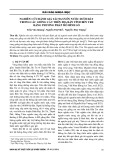
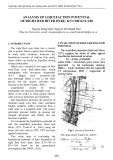

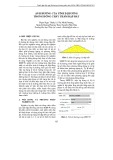
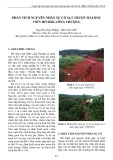
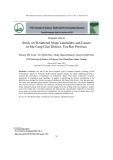
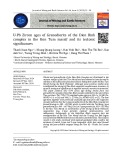
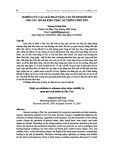

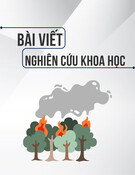

![Quy hoạch tổng thể Cà Mau: Tài liệu [mới nhất/chuẩn nhất]](https://cdn.tailieu.vn/images/document/thumbnail/2025/20250827/tghong1621@gmail.com/135x160/49401756278390.jpg)

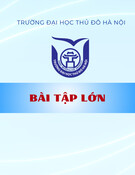
![Bài giảng Hàng hải địa văn [chuẩn nhất]](https://cdn.tailieu.vn/images/document/thumbnail/2025/20250729/vijiraiya/135x160/43361753782101.jpg)
![Bài giảng Trắc địa cơ sở [mới nhất]](https://cdn.tailieu.vn/images/document/thumbnail/2025/20250729/vijiraiya/135x160/84_bai-giang-trac-dia-co-so.jpg)





![Atlas tài nguyên nước Việt Nam: Tài liệu [Mô tả/Hướng dẫn/Chi tiết]](https://cdn.tailieu.vn/images/document/thumbnail/2025/20250715/vijiraiya/135x160/348_tai-lieu-atlas-tai-nguyen-nuoc-viet-nam.jpg)
![Hệ thống câu hỏi ôn tập Vùng kinh tế [chuẩn nhất]](https://cdn.tailieu.vn/images/document/thumbnail/2025/20250709/kimphuong1001/135x160/76921752140578.jpg)
